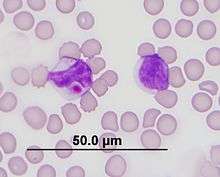Kurloff cells

Kurloff cell and a lymphocyte in a Guinea pig
Kurloff cells (also known as Foà-Kurloff cells[1]) are found in the blood and organs of guinea pigs that contain large secretory granules but are of unknown function (also known as Kurloff bodies). They are also found in the capybara. Scientists speculate that these cells along with asparaginase may be what gives the guinea pig cancer resistant properties (Sharon Vanderlip, DVM). The Kurloff cell has NK cytotoxic activity in vitro.[2][3]
See also
- Zheng Cui, oncologist and Associate Professor of Pathology (Tumor Biology) at Wake Forest University
- Paul Ehrlich, German scientist in the fields of hematology, immunology, and chemotherapy
- Resistance to cancer in naked mole rats
- Russell bodies
References
- ↑ Ledingham JCG (1940). "Sex hormones and the Foà‐Kurloff cell". The Journal of Pathology and Bacteriology. 50 (2): 201–219. doi:10.1002/path.1700500202.
- ↑ James G. Fox; et al. (2002). Laboratory Animal Medicine (2nd ed.). Academic Press. p. 206.
- ↑ Debout C; Quillec M; Izard J (1984). "Natural killer activity of Kurloff cells: a direct demonstration on purified Kurloff cell suspensions". Cellular Immunology. 87 (2): 674–677. doi:10.1016/0008-8749(84)90034-0.
This article is issued from Wikipedia - version of the 10/26/2016. The text is available under the Creative Commons Attribution/Share Alike but additional terms may apply for the media files.